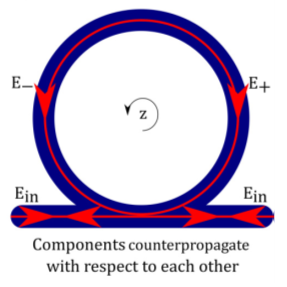Micro-ring resonators and frequency combs
The CNQO group has closely collaborated with Pascal Del’Haye and his research group first at the National Physics Laboratories in England and later at the Max Planck Institute for the Science of Light in Erlangen (Germany). We consider counter-propagation of two light beams in optical micro-ring resonators made of fused silica with diameters of the order of one millimetre (top in Figure 10). Temporal cavity solitons in micro-ring resonators are well known to be the best generators of frequency combs, i.e. a series of sharp, precisely spaced, and pyramidal spectral lines covering a large bandwidth of the optical spectrum. At the base of their origin is again the Kerr optical nonlinearity. Optical frequency combs are enabling unprecedented measurement capabilities and new applications in a wide range of topics that include precision spectroscopy, atomic clocks, ultracold gases, and molecular fingerprinting.
  |
 |
 |
| Fig. 10: Top: Micro-ring resonator. Bottom: Beam powers vs cavity detuning | Fig. 11: Theoretical anti-phase oscillations and power spectra | Fig. 12: Experimental set-up (top) and anti-phase oscillations |
Under balanced conditions of operation with equal inputs and detunings, the system initially displays symmetric outputs where the intensities of the the counter-propagating beams are equal. By increasing the detuning and the input power, a spontaneous symmetry breaking takes place leading to one intensity to be higher than the other (bottom of Figure 10). When this happens the system is prone to temporal instabilities leading to oscillations of the two output intensities (Figure 11 for the theory and Figure 12 for the experiments). Of particular relevance for waveform applications are anti-phase oscillations where the two beams switch dominance on each other.
Recent References
M. T. M. Woodley, J. M. Silver, L. Hill, F. Copie, L. Del Bino, S. Zhang, G.-L. Oppo and P. Del’Haye, “Universal symmetry-breaking dynamics for the Kerr interaction of counterpropagating light in dielectric ring resonators”, Phys. Rev. A 98, 053863 (2018).
L. Hill, G.-L. Oppo, M. T. M. Woodley and P. Del’Haye, “Effects of self- and cross-phase modulation on the spontaneous symmetry breaking of light in ring resonators”, Phys. Rev. A 101, 013823 (2020).
M.T.M. Woodley, L. Hill, L. Del Bino, G.-L. Oppo, and P. Del’Haye, “Self-switching Kerr oscillations of counter-propagating light in microresonators”, arXiv:2005.01411, submitted for publication (2020).